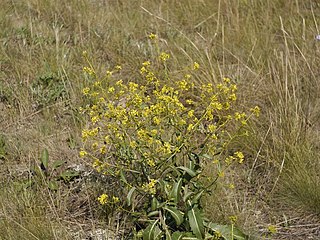
The elongated tortoise is a species of tortoise found in Southeast Asia and parts of South Asia.

Ulmus elongata, also known as the long raceme elm in the US, is a deciduous tree endemic to broadleaf forests in the eastern provinces of China.

The snaggletooth shark, or fossil shark, is a species of weasel shark in the family Hemigaleidae, and the only extant member of the genus Hemipristis. It is found in the Indo-West Pacific, including the Red Sea, from southeast Africa to the Philippines, north to China, and south to Australia, at depths from 1 to 130 metres. This shark can be found near the bottom of the water column of coastal areas, but can be found at continental and insular shelves. Its length is up to 240 cm (7.87 ft). Despite being only vulnerable to extinction, this shark is very rarely seen.

The elongated shrew is a species of mammal in the family Soricidae. It is endemic to the island of Sulawesi in Indonesia. It lives in the forests of central, northern, and eastern Sulawesi from 200 to 2000 meters elevation.

Brassica elongata, the elongated mustard or long-stalked rape, is a species of the mustard plant that is native to parts of Central Europe, Eastern Europe, the Balkan Peninsula, the Caucasus, Morocco and parts of Central Asia. Through plant invasion this species has become naturalized in many other parts of the world. Some of these naturalized regions include South Africa, North Western Europe, Australia and North America. Given the wide range of climate and ecological conditions of these regions, B. elongata has been able to disrupt the ecosystems of their native plant habitats and has been label as an invasive species in many of its naturalized zones. In North America, this species is often found as a roadside weed in the southwestern states, particularly in the state of Nevada. Studies allude that the Cruciferae might have migrated through the Bering land bridge from what is now Central Asia. Commonly known as the long-stalked rape or as langtraubiger Kohl in German, this species is a close cousin to Brassica napus (rapeseed) and a secondary genetic relative to B. oleracea (kale). As a close genetic species of the rapeseed, the long-stalked rape has one of the highest counts of accumulated polyunsaturated linoleic and linolenic acid. Both compounds are heavily used to manufacture vegetable oils. Brassica elongata has the propagative potential of turning into a horticultural product from what is currently a noxious weed.
Corrhenes is a genus of longhorn beetles of the subfamily Lamiinae, containing the following species:
Corrhenes crassicollis is a species of beetle in the family Cerambycidae. It was described by Francis Polkinghorne Pascoe in 1864. It is known from Australia. It contains the varietas Corrhenes crassicollis var. picta.
Corrhenes guttulata is a species of beetle in the family Cerambycidae. It was described by Francis Polkinghorne Pascoe in 1865. It is known from Australia.
Corrhenes sectator is a species of beetle in the family Cerambycidae. It was described by Francis Polkinghorne Pascoe in 1865. It is known from Australia.
Corrhenes stigmatica is a species of beetle in the family Cerambycidae. It was described by Francis Polkinghorne Pascoe in 1863. It is known from Australia.
Corrhenes fulva is a species of beetle in the family Cerambycidae. It was described by Francis Polkinghorne Pascoe in 1875. It is known from Australia.
Corrhenes grisella is a species of beetle in the family Cerambycidae. It was described by Francis Polkinghorne Pascoe in 1875. It is known from Australia.
Corrhenes scenica is a species of beetle in the family Cerambycidae. It was described by Francis Polkinghorne Pascoe in 1863.
Corrhenes funebris is a species of beetle in the family Cerambycidae. It was described by Stephan von Breuning in 1938.
Corrhenes papuana is a species of beetle in the family Cerambycidae. It was described by Stephan von Breuning in 1959.
Corrhenes glauerti is a species of beetle in the family Cerambycidae. It was described by McKeown in 1942. It is known from Australia.
Corrhenes macmillani is a species of beetle in the family Cerambycidae. It was described by Gilmour in 1950.
Corrhenes paulla is a species of beetle in the family Cerambycidae. It was first described by Ernst Friedrich Germar in 1848 as Saperda paulla. It is known from Australia. The Australian Faunal Directory gives the accepted name for this species as Rhytiphora paulla.
Corrhenes mastersi is a species of beetle in the family Cerambycidae. It was described by Blackburn in 1897.

Amanita elongata or Peck's yellow dust amanita is a species of Amanita from Northeastern United States and Canada.





